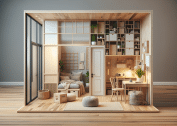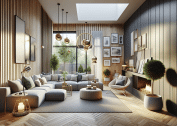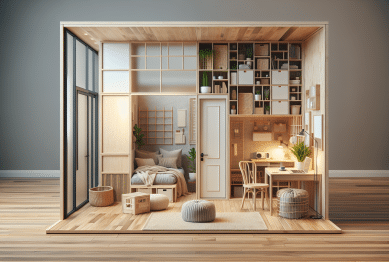Minimalist living rooms have gained popularity for their soothing style and versatile appeal in today’s fast-paced world. Discover how minimalist design combines comfort, function, and personality. Explore ways this approach can transform your environment and daily routines while offering clever decor and clutter-reducing ideas.
Understanding Minimalism Beyond Simple Decor
Minimalism is more than keeping fewer things or making a space look empty. It’s a philosophy rooted in intentional living. The minimalist living room resonates with those seeking calm, clarity, and more intentional use of their space. With every object chosen for both utility and beauty, a minimalist home is about reducing noise and distraction. Each piece serves a clear purpose. By understanding the principles behind this movement, it becomes easy to see why so many people find comfort and happiness in simplified spaces. Minimalism aligns closely with mindfulness, encouraging presence and awareness in daily life. Home environments set the tone for relaxation, and reducing clutter creates harmony.
There’s a common misconception that minimalist decor means giving up comfort or warmth. The opposite is often true. When living rooms are carefully curated, the remaining furniture and accessories gain significance and value. Wondering about the essential elements? Think plush, neutral sofas; tactile rugs; the strategic use of plants; and gentle, diffused light. Natural materials like wood, linen, and wool provide tactile comfort while fitting a streamlined aesthetic. Accessories get chosen intentionally rather than by impulse. By fostering mindful consumption, minimalism encourages sustainable decisions for decor purchases and lifestyle choices. Studies also reveal that decluttered areas contribute to mental clarity and reduced anxiety.
But minimalism does not mean cold or sterile. The style adapts easily to individual needs and cultural influences. Neutral color palettes remain popular, but pops of color—think a single bold cushion or a unique art piece—add personality. Texture is crucial: soft throws or nubby textiles offer coziness without clutter. Plants and organic forms further enliven the space. Personalized minimalism evolves as needs change, ensuring the living room fits both style and daily comfort. The beauty lies in balance—room for both simplicity and the chosen few items that delight and connect. Minimalism can suit large families or single dwellers alike, adapting to scale and life phase.
Key Elements That Shape a Minimalist Living Room
One crucial secret of minimalist living rooms is how every element has a clear role. The foundation often begins with gently colored walls, usually in whites or light greys, which immediately set a calming tone. Large windows, whenever possible, let in plenty of natural light, emphasizing space and openness. Selecting a generously sized, comfortable sofa is top priority, as seating anchors the main gathering area. To define a room, many opt for a single piece of standout artwork or a subtle rug underfoot. By focusing on just a few high-quality pieces, the room feels curated, rather than cluttered, enhancing its peaceful energy.
Storage is another essential building block. Closed cabinetry or minimalist shelving keeps daily necessities within reach but out of sight, supporting both aesthetics and usability. Organizational tricks abound: baskets in natural fiber, modular shelving, and hidden compartments in furniture help maximize function without overwhelming the senses. Even TV units and tables double as storage nooks or drawers. For those with children or pets, washable surfaces and easy-to-clean fabrics prove both beautiful and practical. This practical approach sustains a tidy feel all week long. Ultimately, thoughtful storage is the unsung hero behind the minimalist living room’s effortless tranquility.
Details matter. Rather than scatter many small decorations, choose one or two pieces that reflect treasured memories or passions. A handmade bowl, a family heirloom, or fresh greenery in a clear vase all make personal statements without busyness. The principle of negative space leaves ‘breathing room’ on shelves and tabletops. Clean lines in furniture shapes and lighting fixtures underline the minimalist feel, but curves or textured finishes keep the design inviting and lively. Lighting comes into play, too: layered light sources, such as soft floor lamps or discreet LED strips, allow for ambience control to suit mood and occasion.
The Rise of Multi-functional and Flexible Spaces
Minimalist living rooms thrive in homes where rooms serve many purposes. Open-plan designs continue to gain popularity, enabling a smooth transition between lounging, dining, and working areas. The key challenge? Achieving organization without using too many objects. The answer is furniture that adapts—modular sofas, nesting tables, and fold-away desks allow for easy reconfiguration. This multi-functional approach is especially useful in small apartments or homes where every centimeter counts. Homeowners love how their space grows or shrinks based on needs. It’s smart living for urban and suburban settings alike.
Investing in quality, versatile items supports sustainable design. Many minimalist fans seek furniture made from reclaimed wood, steel, or recycled plastics—pieces that last and can transition from one function to another. For example, ottomans double as seating and storage, while slim benches work as entry tables or extra guest spots. Flexible furnishings make it possible to host gatherings, exercise at home, or tackle art projects without sacrificing order. The trick is to keep large surfaces clear most of the time, adding or removing elements as routines shift throughout the day.
Digital minimalism complements physical space. Integrated technology, from smart lighting to hidden sound systems, minimizes visible cords and devices. Some opt for projectors over large televisions to keep walls uncluttered when entertainment isn’t in use. Others use multipurpose furniture—think a charging station hidden inside a cabinet—to contain electronics. By integrating technology in subtle ways, homeowners maintain a sleek look without giving up modern conveniences. Ultimately, the living room adapts to living, not the other way around.
Benefits of Minimalist Living for Mind and Routine
A minimalist living room doesn’t just look good—it feels good, too. Studies show clear links between tidy environments and improved mood. People report feeling less stressed and more energized when not surrounded by visual clutter. Routines become smoother: cleaning takes less time, objects are easier to find, and daily activities feel more intentional. By removing distractions, the mind can focus on relationships, creativity, and rest. Minimalism, in essence, acts as a platform for better living overall.
This approach aids everyone—from busy professionals to families juggling multiple schedules. Children benefit from focused play areas while adults enjoy calming zones to recharge. Unexpected visitors? The living room remains welcoming and organized, giving peace of mind. For individuals working from home, the minimalist setup fosters productivity, reducing background distractions during video calls or deep work. Notably, living with less can help strengthen gratitude for what is present: a comfortable sofa, cherished photographs, or time spent together.
Minimalist living supports sustainability goals, too. By purchasing fewer, longer-lasting items, households can reduce waste. Carefully chosen local or eco-friendly materials contribute to lower carbon footprints. In fact, the minimalist design movement often overlaps with slow living and environmental awareness. For many, the joy comes not from things but from experiences—shared meals, simple gatherings, and moments of connection. The living room, as a hub, reflects this shift in values. Minimalism, for countless people, is a gentle but powerful way to reclaim time, space, and peace of mind.
Practical Tips for Creating Your Minimalist Sanctuary
Ready to try minimalist living room design? Start with a careful declutter. Begin by removing items that go unused or no longer bring joy. Use baskets or boxes to sort what can be donated, recycled, or stored elsewhere. It’s helpful to go one area at a time: coffee table, bookshelves, then larger furniture. Use this process as a chance to reflect on what really matters to you and your household. Don’t rush—intentional choices last.
Next, select a restrained color palette. White, cream, pale gray, or earthy tones add to the tranquil mood. Coordinate textiles—curtains, cushions, and rugs—for cohesion, but allow a single accent color if desired. Opt for quality over quantity in furniture. A modular sofa, streamlined coffee table, and ample storage should form the basis. Keep surfaces mostly clear. Instead of many decorations, display one or two meaningful objects: a favorite book, a textured vase, or a piece of handmade pottery. Bring nature inside with a healthy indoor plant.
Lighting can make a huge difference. Layer ambient lighting with focused lamps or lanterns for reading or relaxing. Install dimmers for mood control. Reflective surfaces like mirrors bounce natural light across the room, making small areas feel larger. As routines change, reassess what stays: seasonal swaps for blankets, art, or flowers ensure freshness without over-accumulation. Over time, daily tidying becomes easier and more intuitive. Above all, remember: minimalism is personal. Adapt it to suit your tastes, habits, and goals, and let the living room become a source of comfort and joy.
Creating Connection and Warmth Without Clutter
One concern people express about minimalism is whether it’s too impersonal or cold. In reality, true minimalist living rooms reflect their owners’ stories and style. Displaying a family photograph, a travel souvenir, or a handmade piece can make a powerful visual statement. The absence of clutter lets these tokens stand out, inviting conversation and nostalgia. Many families set aside a simple tray or shelf for sentimental items, ensuring meaning over accumulation.
Texture and contrast also help balance the clean lines of minimalism. Try mixing soft wool throws, knotted cushions, or leather stools for a layered look. Rugs with subtle patterns underfoot anchor the seating area and create a sense of welcome. Even minimalist artwork—line drawings, abstract forms, or calming landscapes—can offer focal points. The design encourages gathering, whether it’s for movie night or quiet reading, with versatile furniture and cozy corners.
Finally, don’t overlook scent and sound. Candles, essential oils, or fresh flowers bring warmth. Curate a soft playlist for unwinding in the evening. The minimalist living room is a blank slate, ready to showcase life’s small pleasures. Instead of coldness, the space supports meaningful gathering, mindfulness, and well-being. Minimalism fosters connection, both with others and with oneself, by giving each moment breathing room.
References
1. The Minimalists. (n.d.). What is Minimalism? Retrieved from https://www.theminimalists.com/minimalism/
2. Harvard Health Publishing. (n.d.). Clutter, Stress, and Your Health. Retrieved from https://www.health.harvard.edu/blog/clutter-stress-and-your-health-2019012815730
3. American Psychological Association. (n.d.). Psychology of Interior Design. Retrieved from https://www.apa.org/monitor/2019/02/design
4. Treehugger. (n.d.). Benefits of Minimalism. Retrieved from https://www.treehugger.com/benefits-of-minimalism-4863888
5. Apartment Therapy. (n.d.). How to Design a Minimalist Home. Retrieved from https://www.apartmenttherapy.com/minimalist-home-design-267274
6. Psychology Today. (n.d.). Minimalism Is Good for Your Brain. Retrieved from https://www.psychologytoday.com/us/blog/the-modern-brain/202210/minimalism-is-good-your-brain









